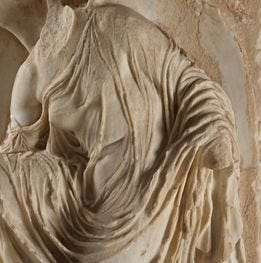Classical art of course had its phases and evolutions, even its own internal revivals of earlier versions of itself. But one phase was the Classicalist of them all, High Classical, The Classical Moment. It arrived with the Greek defeat of the Persian invasion, Thermopylae and the 300 and all that, and with Pericles, presiding over the Golden Age of Athens. It was a time of national pride, and of idealism and rationality. Over in the art world, sculpture had been moving from abstract and generic presentations of the human form, toward individuality, and the expression of an individual’s character. With the high classical, this movement peaked. The high classical aesthetic was a “magical balance” of “two poles of artistic thinking”; the real balanced against the ideal appearance of the human body; the particularity of an individual, against the idea they embodied or the story they told; and as for expression, sculptures “projected a state of mind which was detached but not remote, aware but not involved.”
Then, a dramatic social and political shift. Plague came, and war between Athens and Sparta. An age of outward triumph and confidence gave way to an inward age, of anxiety and uncertainty. The energy which had created High Classical Greece was spent. But the result was not, as might be expected, an “agonized, tortured, insecure” art. Instead we get elegant ornament, and artists exploring the decorative possibilities of drapery. This was the florid, aka the flying drapery style. If the folding and falling of cloth around the human form had always drawn some attention, now it was an obsession: the popular side-show now the main attraction.
As usual, we may ask what drove this aesthetic development. Was it a natural outgrowth of what came before? The pendulum is always swinging. If high classical sculpture showed an aesthetic of magical balance between general and specific, and between outward appearance and inner life, the next stage should destroy that balance and favor the untried extreme: the specific in the absence of the general, a sensitivity to the details of individual appearance for their own sake, a decoupling of that appearance from any larger significance, either for the personality of the person depicted, or the culture in which they live. If high classical sculpture featured important people doing important things, flying drapery sculpture would feature the Goddess of Victory, in a fabulous outfit, adjusting her sandal.
J. J. Pollitt, in Art and Experience in Classical Greece, will have none of this. He rejects a purely internal aesthetic explanation of the florid style. Since the style’s rise coincided with the crumbling of rational optimism into a fear that human affairs were senseless, that crumbling must have participated in the style’s development. The artists behind the florid style were not disinterestedly completing an aesthetic computation left to them by their predecessors; the florid style “must have answered an emotional need.”
But this assertion, if correct, is a puzzle. We’re told both that the florid style is
Keep reading with a 7-day free trial
Subscribe to Mostly Aesthetics to keep reading this post and get 7 days of free access to the full post archives.





